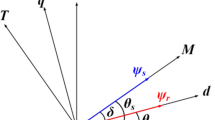Abstract
A control area network (CAN) based multi-motor synchronized motion control system with an advanced synchronized control strategy is proposed. The strategy is to incorporate the adjacent cross-coupling control strategy into the sliding mode control architecture. As illustrated by the four-induction-motor-based experimental results, the multi-motor synchronized motion control system, via the CAN bus, has been successfully implemented. With the employment of the advanced synchronized motion control strategy, the synchronization performance can be significantly improved.
Similar content being viewed by others
References
R. D. Lorenz, P. B. Schmidt. Synchronized Motion Control for Process Automation. In Proceedings of IEEE Industry Applications Annual Meeting, IEEE Press, Piscataway, USA, vol. 2, pp. 1693–1698, 1989.
Y. Koren. Cross-coupled Biaxial Computer for Manufacturing Systems. Journal of Dynamic Systems, Measurement, and Control, vol. 102, no. 4, pp. 265–272, 1982.
M. Tomizuka, J. S. Hu, Chiu, T. C. Chiu, T. Kamano. Synchronization of Two Motion Control Axes under Adaptive Feedforward Control. Journal of Dynamic Systems, Measurement, and Control, vol. 114, no. 2, pp. 196–203, 1992.
S. S. Yeh, P. L. Hsu. Analysis and Design of Integrated Control for Multi-axis Motion Systems. IEEE Transactions on Control Systems Technology, vol. 11, no. 3, pp. 375–382, 2003.
D. Sun, J. K. Mills. Adaptive Synchronized Control for Coordination of Two Robot Manipulators. In Proceedings of IEEE International Conference on Robotics and Automation, IEEE Press, Washington DC, USA, vol. 1, pp. 976–981, 2002.
D. Sun. Position Synchronization of Multiple Motion Axes with Adaptive Coupling Control. Automatica, vol. 39, no. 6, pp. 997–1005, 2003.
F. J. Perez-Pinal, G. Calderon, I. Araujo-Vargas. Relative Coupling Strategy. In Proceedings of IEEE International Conference Electric Machines and Drives, IEEE Press, Wisconsin, USA, vol. 2, pp. 1162–1166, 2003.
Y. Xiao, K. Y. Zhu. Cross-coupling Generalized Predictive Control for Motion Systems. In Proceedings of the 7th International Conference on Control, Automation, Robotics and Vision, Nanyang Technological University, Singapore, pp. 1664–1669, 2003.
Y. Xiao, K. Y. Zhu. Optimal Synchronization Control of High-precision Motion Systems. IEEE Transactions on Industrial Electronics, vol. 53, no. 4, pp. 1160–1169, 2006.
F. Chen, M. W. Dunnigan. Sliding-mode Torque and Flux Control for an Induction Machine. IEE Proceedings: Electric Power Applications, vol. 150, no. 2, pp. 227–236, 2003.
F. J. Perez-Pinal, C. Nunez, R. Alvarez, I. Cervantes. Comparison of Multi-motor Synchronization Techniques. In Proceedings of the 30th Annual Conference of IEEE Industrial Electronics Society, IEEE Computer Society, Piscataway, USA, pp. 1670–1675, 2004.
D. D. Blair, D. L. Jensen, D. R. Doan, T. K. Kim. Networked Intelligent Motor-control Systems. IEEE Industry Applications Magazine, vol. 7, no. 6, pp. 18–25, 2001.
G. C. Walsh, Y. Hong. Scheduling of Networked Control Systems. IEEE Control Systems Magazine, vol. 21, no. 1, pp. 57–65, 2001.
F. L. Lian, J. Moyne, D. Tilbury. Network Design Consideration for Distributed Control Systems. IEEE Transactions on Control Systems Technology, vol. 10, no. 2, pp. 297–307, 2002.
C. C. Hsieh, A. P. Wang, P. L. Hsu. CAN-based Motion Control Design. In Proceedings of Annual Conference on SICE, IEEE Press, Fukui University, Fukui, Japan, vol. 3, pp. 2504–2509, 2003.
F. He, W. Tong, Q. Wang. Synchronization Control Strategy of Multi-motor System Based on Profibus Network. In Proceedings of IEEE International Conference on Automation and Logistics, IEEE Press, Piscataway, USA, pp. 3029–3034, 2007.
B. Chen, Y. P. Chen, J. M. Xie, Z. D. Zhou, J. M. Sa. Control Methodologies in Networked Motion Control Systems. In Proceedings of the 4th International Conference on Machine Learning and Cybernetics, IEEE Press, Piscataway, USA, vol. 2, pp. 1088–1093, 2005.
R. Marino, S. Peresada, P. Valigi. Adaptive Input-output Linearzing Control of Induction Motors. IEEE Transactions on Automatic Control, vol. 38, no. 2, pp. 208–221, 1993.
V. I. Utkin. Sliding Mode Control Design Principles and Applications to Electric Drives. IEEE Transactions on Industrial Electronics, vol. 40, no. 1, pp. 23–26, 1993.
J. Ferreira, P. Pedreiras, L. Almeida, J. A. Fonseca. The FTT-CAN Protocol for Flexibility in Safety-critical Systems. IEEE Micro, vol. 22, no. 4, pp. 49–55, 2002.
C. C. Hsieh, P. L. Hsu. The Event-time Triggered Network Control Structure CAN-based Motion Systems. In Proceedings of IEEE Conference on Control Applications, IEEE Press, New York, USA, pp. 722–726, 2005.
Author information
Authors and Affiliations
Corresponding author
Additional information
This work was supported by National Natural Science Foundation of China (No. 69774011)
Jun Ren received his B. Sc. degree in automation, in 1999, and his M. Sc. degree, in 2002, in process control of papermaking from South China University of Technology, PRC. He is currently a Ph. D. candidate in the Control Theory and Application Group of the Department of Automation, Tsinghua University, PRC.
His research interests include networked control, motion control, and nonlinear control.
Chun-Wen Li is a professor in the Control Theory and Application Group of the Department of Automation, Tsinghua University, PRC.
His research interests include nonlinear control, motion control, and electric power control.
De-Zong Zhao received his B. Sc. and M. Sc. degrees in automation from Shandong University, PRC, in 2002 and 2006, respectively. He is currently a Ph.D. candidate in the Control Theory and Application Group of the Department of Automation, Tsinghua University, PRC.
His research interests include synchronized motion control and motor control.
Rights and permissions
About this article
Cite this article
Ren, J., Li, CW. & Zhao, DZ. CAN-based synchronized motion control for induction motors. Int. J. Autom. Comput. 6, 55–61 (2009). https://doi.org/10.1007/s11633-009-0055-1
Received:
Revised:
Published:
Issue Date:
DOI: https://doi.org/10.1007/s11633-009-0055-1




